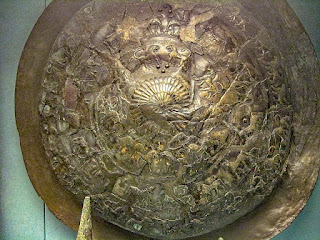Most of the knowledge regarding Urartu comes from a series of clay tablets found among ancient Assyrian ruins. They hold the reports from Assyrian intelligence agents that were sent to various cities in Urartu. These clay tablets give us a record of history for a period of time around 714 BCE.
The people of Urartu referred to themselves as “Biainili.” Urartian texts have shown that the kings of Urartu often called themselves the “king of the land of Biaini,” and in Assyrian texts, Urartian kings were labeled the “king of the land of Nairi.” The land of Nairi/Biaini is known to be the land surrounding Lake Van (or the Sea of Nairi). Hebrew texts referred to Urartu as the “Kingdom of Ararat.” Historians believe that over the entire span of the kingdom’s life, people of Mitanni, Khurry, Khaldea, and Hittite blood lived among the Urartians during its early history. Its later inhabitants, those that eventually brought the kingdom to its end, were the Phrygians, Moskes, Armens, Scythians, Alans, and Cimmerians. Some of these groups were brought to Urartu as prisoners of conquest and were often put to work in labor forces. - Armenian National Committee of America Western Region.
Lake Van at the heart of the kingdom is a salt water lake which provided salt and an ecosystem that sustained diverse agricultural products including cotton, mulberry trees, grapevines, apricots, peaches, pomegranate, other fruit trees, and rice. The surrounding mountains were rich in minerals as well, yielding crystals, naphtha, copper, salt, iron, lead, silver, gold, borax, arsenic, and semi-precious stones. Urartians were expert metal workers and also practiced forestry and raised cattle. Their horses, were trained for cavalry and chariots and Urartian charioteers were renowned.
 |
| Griffin-headed demon, blackened ivory. Forms a pair with another similar sculpture, but made in white ivory. They may have been part of the decoration of a throne. 8th-7th century BC, Urartu, from Toprakkale (East Turkey) now in the British Museum, courtesy of Wikimedia Commons contributor Zunkir. |
 |
| Lead figure with glass and ivory inlays, 8th-7th century BCE. From Toprakkale, eastern Turkey, kingdom of Urartu, now in the British Museum, courtesy of Wikimedia Commons contributor Zunkir. |
 |
| Urartian goblet shaped like a shoe courtesy of Wikimedia Commons contributor EvgenyGenkin
|
 |
| Urartian fresco courtesy of Wikimedia Commons contributor EvgenyGenkin |
 |
| Urartian bull head probably once an attachment to a bronze cauldron courtesy of the Cleveland Museum of Art.
|
 |
| Urartian bronze Lamassu figurine from Toprak-kale, 9th-7th centuries BCE at The Hermitage Museum courtesy of Wikimedia Commons contributor EvgenyGenkin |
 |
| Urartian cauldron at the Museum of Anatolian Civilizations in Ankara, Turkey courtesy of Wikimedia Commons contributor Evgeny Genkin
|
 |
| An alloy of gold and silver pectoral depicting a kneeling figure (bringing a sheep; sacrifice) in adoration before an enthroned deity (holding a bowl in one hand and a plant in the other). The scene is flanked by 2 stylized trees. From Toprakkale (Rusahinili), Turkey. Urartian, 8th-7th century BCE. Pergamon Museum, Berlin, Germany, courtesy of Wikimedia Commons contributor Osama Shukir Muhammed Amin FRCP(Glasg). |
 |
| Fragments of a horse engraving from a wall in Rusahinili, ancient Urartian fortress built by Rusa I, 735–714 BCE, located near the modern city of Van in eastern Turkey courtesy of Wikimedia Commons contributor EvgenyGenkin now in The Hermitage Museum. |
 |
| Urartian bronze quiver with chariots motif that once belonged to Sarduri II, 764–735 BCE, at The Hermitage Museum Turkey courtesy of Wikimedia Commons contributor EvgenyGenkin |
 |
| Cast and incised bronze furniture fittings. Urartian, late 8th century BC from Toprakkale now in the British Museum courtesy of Wikimedia Commons contributor ClaireH. |
 |
|
| Urartian Bronze Finial in the shape of a winged and horned lion 8th-7th century BCE courtesy of Phoenix Ancient Art.
|
 |
| Pointed Urartian helmet at the Badisches Landesmuseum in Karlsruhe, Germany courtesy of Wikimedia Commons contributor Thomas Ihle. |
 |
| Urartian throne leg with male ruler or deity standing over a kneeling bull, 8th-7th century BCE at The Hermitage Museum courtesy of Wikimedia Commons contributor EvgenyGenkin |
 |
| Urartian bronze Lamassu figurine from Toprak-kale, 9th-7th centuries BCE at The Hermitage Museum courtesy of Wikimedia Commons contributor EvgenyGenkin |
 |
| Urartian, about 650 BCE From Toprakkale. Inscription reads "Rusa, son of Erimena, mighty king, great king, lord of the city of Tushpa, now in the British Museum courtesy of Wikimedia Commons contributor ClaireH. |
 |
| Urartian pottery with bull protomes at the Erebuni Museum in Armenia courtesy of Wikimedia Commons contributor Gegman. |
 |
| Ivory carvings of Urartian protective deity now in the Museum of Anatolian Civilizations in Ankara, Turkey, courtesy of Wikimedia Commons contributor EvgenyGenkin |
 |
| Urartian Tree of Life courtesy of Wikimedia Commons contributor EvgenyGenkin. |
 |
| A leg of the Urartian chandelier found at Rusahinili now in the Museum of Anatolian Civilizations in Ankara, Turkey, courtesy of Wikimedia Commons contributor EvgenyGenkin |
 |
| Urartian bronze quiver with chariots motif that once belonged to Sarduri II, 764–735 BCE, at The Hermitage Museum Turkey courtesy of Wikimedia Commons contributor EvgenyGenkin |
If you enjoyed this post, never miss out on future posts by following me by email!





















No comments:
Post a Comment